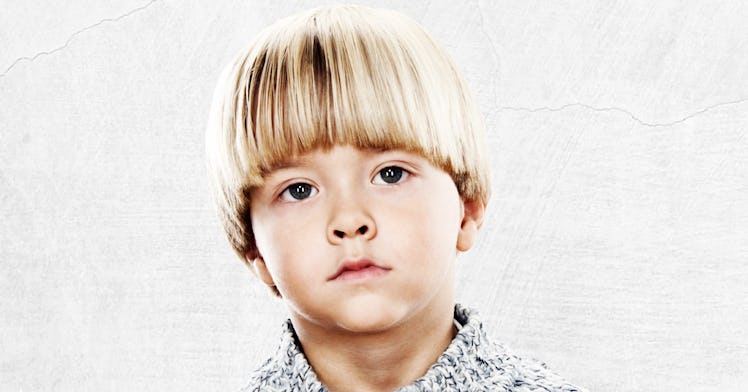The Bowl Cut — Yes the Bowl Cut — Is Now a Symbol of Hate
The once-innocent cut has now become a symbol of something else entirely.

For centuries, the Swastik was a symbol of spiritualism and divinity in Indian cultures. Before it was adopted and reversed into the Hakenkreuz by Germany’s National Socialist Party in 1920, the sanskrit symbol was was a good luck charm the world over. After the symbol became Hitler’s go-to emoji, the sauwastika fell out of favor and was scrubbed off many a temple and public building. Since that time, modern hate groups have ruined plenty of other perfectly nice things by coopting them as symbols of a bigoted agenda. The Celtic cross, Grafters boots, tiny, square mustaches are all examples. In America, white nationalist organizations have been particularly adept at this, picking up the “okay” hand gesture, the Coors logo (seriously), and, more recently, black Fred Perry polo shirts.
Bigots are now scooping up symbols at such speed that the Anti-Defamation League just added 36 new entries to its online “Hate on Display” database of hate symbols, including, a cartoon moon man wearing sunglasses from an old McDonald’s commercial. Also,the bowl haircut. Yes, the bowl haircut. The grooming look favored by Medieval monks, the Beatles, that kid in Mrs. Doubtfire, and your slightly chubby middle school best friend.
Also, Dylann Roof.
Roof, who sported the haircut, was the white supremacist responsible for killing nine people at the Emanuel African Methodist Episcopal Church in Charleston, South Carolina. Soon after, haircut started to surface on white supremacist forums online. As Rolling Stone reported:
“On white supremacist chat forums on platforms like Gab and Discord, the bowl cut takes a few different forms. Images of Roof’s hair are often photoshopped on other people in various white supremacist memes (one popular meme features Roof’s bowl cut superimposed on an SS military shield); some white supremacists will also Photoshop a halo or a glowing effect around Roof’s head for emphasis. The bowl cut is also used as verbal shorthand within fringe groups, with white supremacists referring to themselves as “the bowl gang” or inserting “bowl” into other words, such as swapping out “brother” for “bowlther.” There is even a white supremacist called the BowlCast, named after Roof’s distinctive cut.
If you think about it, the bowl cut is made to be a meme. The plainness of it mixed with certain alt-right groups desire to canonize Roof’s actions makes it ideal iconography. It’s a stupid symbol. But what about internet memes isn’t stupid? That’s the point of them. They’re silly fun. (A Far Side cartoon once famously described bowl cuts as nature’s way of saying “do not touch.”) But silly fun becomes silly hate when symbols fall into the wrong hands.
The scary thing about all of this is that these codes change so quickly that they are nearly impossible to keep up with for those not devoting themselves entirely to doing so. We know this from dealing with very online lingo. Every now and again, a list of teen-isms surfaces online with the shit-bait headline of “What are your kids REALLY saying online?”. These lists are really built to alarm parents and alert them to fact that “hundo p” is short for “one hundred percent” or that “ship” is short for “relationship.” (Not really calculus, is it?) Then, there are lists that surface by local police stations about the secret text codes or hashtags kids use to get over their parents. These lists are full of information like “RU 18” means “Are You 18?” or that swag means confidence. There are phrases that seem crazy but aren’t, such as IANAL, which, no doesn’t mean what you think it means and is instead short for “I am not a lawyer.” (Do people actually text that? Who knows.)
Despite its place in the mortifying-things-our-parents-did-to-us hall of fame, the bowl cut is, for many, a symbol of childhood — of innocence and awkward school photos and funny stories from parents about how, in an effort to make ends meet, they gave their kids embarrassing haircuts. We look back fondly at silly photographs of ourselves with dumb haircuts and laugh. Sometimes we post them online so others can share and reminisce in the awkwardness. But now even the bowlcut has been reformed into a symbol of hate, one that exists in the same categorization as the swastika. That’s what hate groups do so well: they pervert pure, seemingly insignificant cultural artifacts, sharpen their blunt edges, and use them as weapons. This is, as they say, why we can’t have nice things.
Does this mean you sprint to Walmart, grab some pomade, and style your kid’s bowl cut into something more acceptable? Of course not. It’s not like some stranger is going to come down the street and accuse your toddler of Aryan Brotherhood-ism just because you own a salad bowl and some pretty sharp Fiskars. It does mean that we all need to be more conscious of what might be misconstrued as hate so as to avoid them when necessary. The world demands it.
This article was originally published on